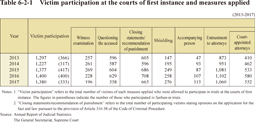Chapter 2 Victims in Criminal Justice Process
Under victim participation system, the court may allow the victim or others to participate in the proceedings of the case by a ruling, to appear on the trial dates, to state an opinion on the finding of facts or the application of law, and to ask the defendant questions for the purpose of stating such an opinion.
Table 6-2-1 shows the status of victim participation in the trial at the court of first instance.
Table 6-2-1 Victim participation at the courts of first instance and measures applied
Separately from the aforementioned victim participation, the court is to allow the victim to state an opinion. The court may apply the measures for witness protection at trial such as placing a shield, allowing the witness to stay in a separate room and video-link with the courtroom during the testimony, and/or allowing the witness to be accompanied by an appropriate accompanying person.
Another protective measure is that the court, upon a request, may render a ruling that the name, address or other matters of the victim of sexual offenses and others do not be disclosed in an open court.
Civil settlement reached with the offender could become an enforceable title of obligation if the terms of the settlement are included in the trial record of the criminal case. Also, the court of the criminal case of a specific serious offense may, upon the request by the victim of the crime, continue with the civil case using the record of the criminal case after the conviction and render a compensation order.
In addition, the court, in general, allows victims to inspect and copy the case records.
Table 6-2-2 shows the status of such measures applied to victims or witnesses.
Table 6-2-2 Measures for victims/witnesses applied

